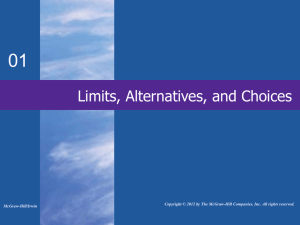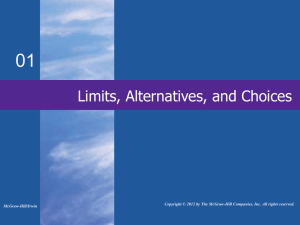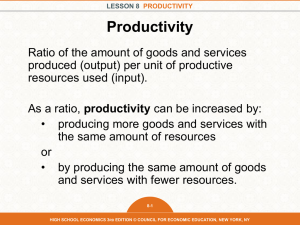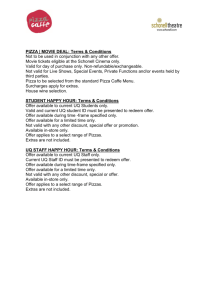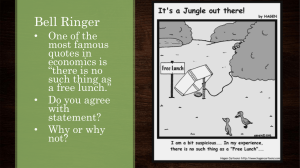Limits, Alternatives, and Choices
advertisement
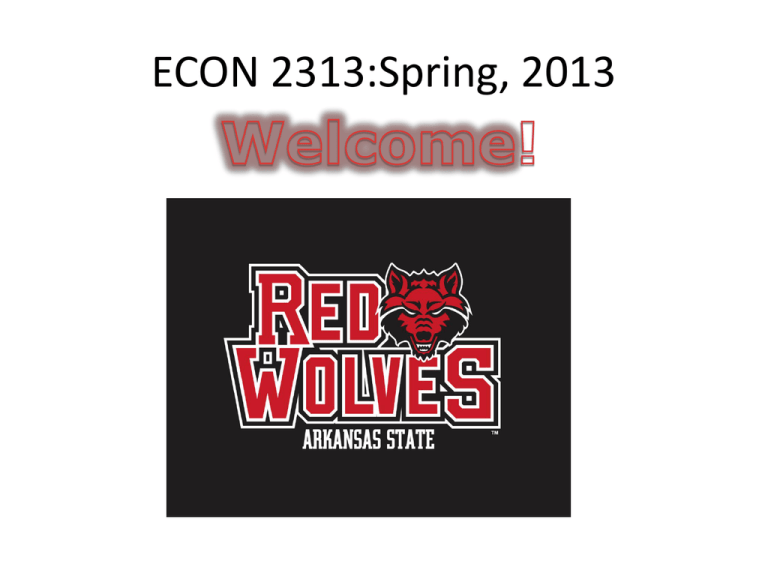
ECON 2313:Spring, 2013 Economics is the study of how individuals and societies allocate scarce resources among (competing) alternative uses. Available resources are insufficient to satisfy wants. We cannot produce enough goods and services to satisfy everyone—we don’t have the resources! Congress made supplemental appropriations for the Iraq effort of $110 billion June 2003 and March 2004. We should ask the question: What could we have for $110 billion? •628 Boeing 7E7 Aircraft • Construct three (3) 700 mile bullet trains (includes the cost of inner-city land acquisition). •4,075 “high quality” educational facilities to accommodate 1,000 students. •Fund 1,000 universities the size of Arkansas State for one year. The geneology of economics Economics Webster’s Ninth New Collegiate Dictionary. eco• nom • ic 1. archaic: of or relating to a household or its management. eco = oikos, meaning “house” or “household” nom = nemein, meaning “to manage” ic = ic, mean “of” or “relating to” Finley. The World of Odysseus. The Economic Perspective • Thinking like an economist • Key features: • Scarcity and choice • Purposeful behavior • Marginal analysis LO1 1-7 Economics: The Big Questions •How do choices end up determining what, how, and for whom goods and services are produced? •When do choices made in the pursuit of self-interest also promote the social interest? Do “public virtues spring from private vices”? Economic Resources Things that give us the physical means to produce and distribute goods and services. • • • • Land Labor Capital Entrepreneurship Land or natural resources Labor or “human resources” Capital or “manmade instruments of production” Human Capital Human capital is the knowledge and skill people obtain from education, onthe-job training, and work experience. Entrepreneurship Entrepreneurship is the willingness and ability to combine land, labor and capital into productive enterprises. •Entrepreneurs identify profitable business opportunities and mobilize and coordinate resources to take advantage. •Entrepreneurs have a key role in the commercialization of new knowledge •Sam Walton, Michael Dell, Martha Stewart, and Bill Gates are examples of highly successful entrepreneurs. What, How, For Whom? Because resources are scarce, growing more corn means growing less wheat, building more SUV’s means building fewer military vehicles, and building more prisons means we have to sacrifice something else— like new schools. How to produce? •In France, basket-carrying workers pick the grape crop by hand. Grape picking in California is often mechanized. •GM uses workers to weld body parts together in some plants and uses robots in others. For whom are goods produced? Occupation Chief Executives Airline Pilots and Co-Pilots Dentists Marketing Managers Actuaries Speech Pathologists Registered Nurses Funeral Directors Food Service Managers Mean Annual Income ($) $139,810 135,040 133,680 101,190 90,760 58,000 56,880 56,540 44,930 Source: Bureau of Labor Statistics 2005 Occupational Survey The personal distribution of income describes the distribution of income among households or individuals Household Income Ratios of Selected Percentiles, the United States 12 10 Ratio 8 6 90th/10th 80th/50th 4 2 0 1967 1990 Year 2008 Source: Bureau of the Census Shares of Household Income Quintiles, the United States 60 Share (Percent) 50 40 Lowest Second 30 Middle 20 Fourth Highest 10 0 1967 1990 Year 2008 Source: Bureau of the Census When is the Pursuit of Self-Interest in the Social Interest? • Subprime mortgage brokers and underwriters behaved in their own interests—but contributed to the housing prices bust. • BP scrimped on deep water drilling safety measures—with catastrophic results. • Farmers on the high plains draw from the Ogallala Aquifer—but the water is rapidly running out. Microeconomics The study of the choices that individuals and businesses make and the way these choices respond to incentives, interact, and are influenced by government Examples of microeconomic questions? •What determines the price of gasoline? •Why is housing so much more expensive in San Francisco compared to Dallas? •Will more students enroll in nursing schools in response to rising incomes of nurses? •Will the “free” availability of Linux affect sales of Windows? Macroeconomics The study of the aggregate (or total) effects on the national economy and the global economy of the choices that individuals, businesses, and governments make. Macroeconomic Questions •The standard of living •The cost of living •Economic fluctuations—recessions and expansions The Standard of Living The standard of living is (imperfectly) measured by the average quantity of goods and services per person (or per capita). Issues: •How to explain changes over time in the standard of living? •How to explain cross-national differences in the standard of living? The Cost of Living The cost of living refers to the prices of goods and services that are typically purchased by households. Issues: •How to explain changes over time in the cost of living? •How to explain cross-national differences in the cost of living? The Business Cycle Time The term business cycle is used to describe observed fluctuations in key macroeconomic measures such as real GDP, personal income, profits, or employment. A full cycle consists of an expansion and a contraction (or recession). Business cycles are recurring phenomena; however, they are irregularly recurring. Total Production Business Cycle Phases and Turning Points Peak Expansion Peak Expansion Recession Recession 2 Trough 4 8 Year Nonfarm employment decreased by 8.8 million between January 2008 and February 2010, an average of 351,000 jobs lost per month. Purposeful Behavior • Rational self-interest • Individuals and utility • Firms and profit • Desired outcomes LO1 1-33 Economists assume that economic decision-makers are rational and engage in purposeful, “maximizing” behavior Rationality means: • The ability to make comparisons and form preferences. • Choice consistency Gift Baskets A C 1. I prefer A to B 2. I prefer B to A 3. I am indifferent between A and B 4. I prefer B to C 5. Therefore, I prefer A to C B Economics deals with questions of “what is” and “what ought to be.” The former set of questions belong to positive economics; the latter to normative economics “All swans are white.” “Pink swans are prettier than white swans.” Positive economics attempts set forth scientific statements --that is, statements subject to verification or falsification For instance: • If they raise tuition again at ASU, enrollment will decline. •Quantitative easing (QE) by the Federal Reserve system will be inflationary. • Total employment in the U.S. fell in the year 2009. It’s unfair to ask a person to live on $7.25 an hour. I shouldn’t have the government telling me how much I should pay for fast food cooks or any other type of labor service. Who is right? It is a normative issue. What is an Economic Model? An economic model is a simplified substitute for economic reality. This map of Arkansas is a good example of a “model” Ceteris Paribus “All other things being equal” or “All other factors held constant.” Simplification in model building is achieved by the ceteris paribus assumption. It allows us to reason about the relationship between two variables without the intrusion of other variables. Application of Ceteris Paribus: Sales of Pizza SP/Week =f(PP, PT, PH, Income, . . . ) Where, SP/Weeks is pizzas sold per week PP is the price of pizza PT is the price of tacos PH is the price of hamburgers To isolate on the responsiveness of pizza sales to a change in pizza prices, hold all other factors constant. •Post hoc fallacy •Association-is-causation fallacy •Fallacy of composition I washed my car today, and that is why it rained. Correlation versus Causation Correlation is the tendency for the values of two variables to move in a predictable and related way. For example, beer consumption tends to rise when unemployment rises—that is, these variables are correlated. Does it follow that beer consumption causes unemployment? Sleeping with one's shoes on is strongly correlated with waking up with a headache. Therefore, sleeping with one's shoes on causes headache. • Researchers at the Aabo Akademi found that Finns who speak the language of their Nordic neighbors were up to 25 percent less likely to fall ill than those who do not. • My rooster died—the sun won’t come up tomorrow. • Crimes rates tend to be higher in cities with more police per capita. To commit the fallacy of composition is to suppose that what is true in the individual case also holds true for the group. •Example: “The best way to leave a burning theater is to run for the exit.” Individual’s Economizing Problem • • • Limited income Unlimited wants A budget line • • • • LO4 Attainable and unattainable options Tradeoffs and opportunity costs Make the best choice possible Change in income 1-52 Individual’s Economizing Problem 12 DVDs Books $20 $10 10 6 0 5 2 4 4 3 6 2 8 1 10 0 12 Quantity of DVDs $120 Budget Income = $120 =6 Pdvd = $20 8 Unattainable 6 Income = $120 = 12 Pb = $10 4 2 0 Attainable 2 4 6 8 10 12 Quantity of Paperback Books LO4 14 1-53 Global Perspective LO4 1-54 Production Possibilities Model • Illustrates production choices • Assumptions: • Full employment • Fixed resources • Fixed technology • Two goods LO5 1-55 Technology Technology is the application of scientific or other types of know-how to practical tasks. •“A sharp axe is better than a dull axe.” •Improved technology enables us to produce more with the same resources. •“Specialization is the inevitable counterpart of technology.” John K. Galbraith. The New Industrial State (1967). Model T : 1903 Ford Mustang: 1964 Important technical innovations • • • • • • • • • • Internal combustion engine Cotton harvester Transistor Internet browser software Air conditioning Satellite communication Antibiotics Hypertext markup language Genetically modified seeds Multi-modal freight containers Production Possibilities Table Production Alternatives A B C D E Pizzas 0 1 2 3 4 Industrial Robots 10 9 7 4 0 Type of Product (in hundred thousands) (in thousands) Plot the Points to Create the Graph LO5 1-59 Industrial Robots Production Possibilities Curve 14 13 12 11 10 9 8 7 6 5 4 3 2 1 The law of increasing opportunity costs makes the PPC concave. X A B C Unattainable D U Attainable E 0 1 2 3 4 5 6 7 8 9 Pizzas LO5 1-60 Marginal Benefit & Marginal Cost Optimal Allocation 1 5 MC a c MB = MC e 1 0 5 LO5 b d MB 1 2 Quantity of Pizza 3 1-61 Marginal Benefit (MB): The addition to society’s total benefits attributable to the last unit produced. MC: The addition to society’s total cost attributable to the last unit produced. G.I. Bill Robert Solow Henry Ford, Thomas Edison— Pioneers in “process innovation.” Depletion of nonrenewable resources Australian rabbit menace A Growing Economy • Economic Growth • More resources • Improved resource quality • Technological advances LO6 1-63 A Growing Economy Production Alternatives A' B' C' D' E' Pizzas 0 2 4 6 8 Industrial Robots 14 12 9 5 0 Type of Product (in hundred thousands) (in thousands) LO6 1-64 Industrial Robots A Growing Economy 14 13 12 11 10 9 8 7 6 5 4 3 2 1 A’ B’ Unattainable A B C’ C Economic Growth D’ D Now Attainable Attainable E’ E 0 1 2 3 4 5 6 7 8 9 Pizzas LO6 1-65

